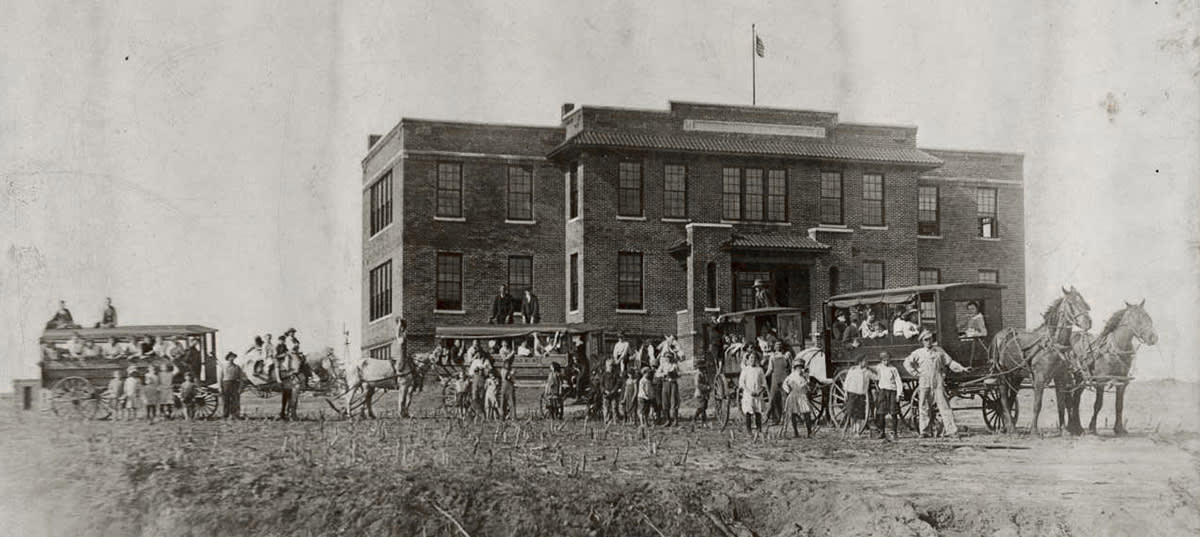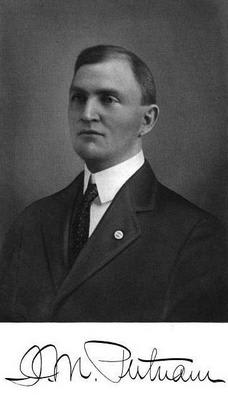DISTRICT HISTORY

Early History
In May 1914 a group of parents west of Oklahoma City gathered to discuss how their children could best be educated. The solution they chose was the consolidation of four one-room country schools. Consolidated District No. 1 at Putnam City was born.Putnam City School
By 1915, students were attending classes in a "most substantial and handsome brick structure," (see photo) an early newspaper reported. The building, at the site of the present day N.W. 40th and Grove, had six classrooms, an auditorium, a superintendent’s office and a "commodious basement." There was no cafeteria, so students brought their own lunches. The school was otherwise equipped with electric lights and all modern conveniences of the day.
Students at all levels, primary through secondary, attended the school. Students within two miles of the school walked or rode horses. (There was a shed for horses ridden by students.) Students who lived farther away could be transported to and from school in horse-drawn enclosed wagons.
Taxpayers and patrons were highly pleased with the school. "Not only are the pupils afforded a much more comprehensive course of study by having the schools grouped, but the new building furnishes a meeting place for social and civic activities of the district," the newspaper reported.
To learn more about Putnam City's history, read page 5 of the January 2007 issue of Info Magazine from the Metropolitan Library System.
Is There a City of Putnam City?
"Putnam City" was the name given to 2,000 acres of land owned by Israel Mercer Putnam, an early-day Oklahoma real estate developer and legislator. Putnam had the area platted as city but never filed incorporation papers with the state that would have made it official. Putnam proposed to Gov. Haskell and a State Capitol Commission that the State Capitol be established on his land, a proposal the governor and commission approved. Those arrangements fell apart when the Oklahoma Supreme Court ruled the governor and commission needed legislative approval. The legislature instead chose an area at N.W. 23rd and Lincoln, freeing "Putnam City" for a new and different future.
See Putnam City History Firsthand
The Putnam City Schools Museum has a large collection of yearbooks, photos, scrapbooks, artifacts, trophies, posters and other memorabilia from years past. All schools are represented in the museum's collection. The museum, located at 4101 N. Grove ( the northwest corner of N.W. 40th and Grove Ave.) is open each Saturday from 10 a.m. to 2 p.m.
Israel Mercer Putnam
Israel Mercer Putnam, an early-day Oklahoma land developer and legislator, was a trailblazer. In the early 1900s, Putnam owned 2,000 acres of land west of Oklahoma City. He promoted the area as "Putnam City," close to the big city of Oklahoma City but still a quiet, suburban atmosphere.
Putnam planned for Putnam City to become the site of the the new state capitol. For a few months in 1910, his efforts succeeded. A state capitol commission accepted his proposal of land for the capitol. In December 1910, however, the Oklahoma legislature rejected that agreement and instead chose to have the state capitol constructed in northeast Oklahoma City.
When Putnam's plans fell through, the land and a building Putnam had constructed became available for other uses. That's when several one-room schools merged, and Independent School District No. 1 (later known as Putnam City Schools) was born.

